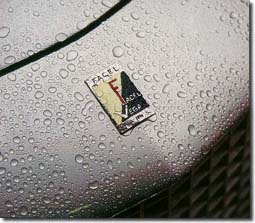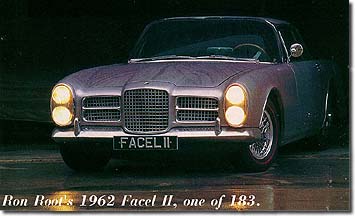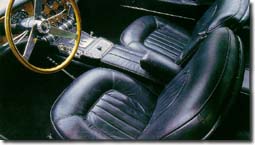Since he counted heavily on the lucrative US market, Daninos continually upgraded his car to appeal to rich American motorists. By 1956, the firm had added the ubiquitous wraparound windshield and De Soto’s latest 5.4-liter (330-cid), 255-bhp V8, which was also rated at 285 bhp in Europe. Road & Track used one of these to toss off a 0-60 run in 9.3 seconds, the quarter mile in 17.0 @ 83 mph and a top speed of 121.1 mph, all with the 2-speed PowerFlite. The Pont-a-Mousson 4-speed would have meant even faster acceleration at the price of top speed.

And then, in 1957, a number of interesting things happened. First, Chrysler began supplying Facel with the 5.8-liter (352-cid), dual-quad Hemi from the Chrysler 300-C. Though this engine was officially derated from the 375 bhp it was advertised with in the States, Facel still promised a healthy 325 horses from their hybrid. Hans Ruhe also points out that due to a 1956 oil crunch in Europe, Facel started putting smaller V8s into cars sold on the continent while continuing to use the largest engines available in those bound for America. The 2-speed PowerFlite also became a 3-speed TorqueFlite in 1957, and the Facel Vega coupe took on quad headlights and England’s Hydrosteer power steering unit as standard equipment.
Nineteen-fifty-seven was also the year that Daninos released a 4-door sedan, the Facel Vega Excellence, at the Paris salon. The Excellence amounted basically to a stretched, 4-door version of the coupe, which was simultaneously renamed FVS (for Facel Vega Sport). Nineteen inches were added to the wheelbase, and the sedan’s rear body styling looked very much like the 1958 Cadillac’s (or vice-versa). The totally pillarless Excellence, whose door strikers mounted at the rocker sills, was often accused of being structurally flexible, but at least one tester, Motor Trend’s Wayne Thoms, disagreed. "We found no twist within the long, open-box body," he wrote, "the result of a rigid, tubular frame that shows some forward thinking at the design level." In 1959, Facel advertised the Excellence as the fastest production 4-door on the road, mentioning a top speed of 140-150 mph.

 At about the same time as the arrival of the sedan, American distribution of the Facel Vega marque was taken up by Max G. Hoffman and the colorful George Abecassis got the franchise for England. By now, Facel Vegas had gained a very international flavor: They originated in France but used American engines and (automatic) transmissions, British brakes and axles, and a selection of Italian wheels.
At about the same time as the arrival of the sedan, American distribution of the Facel Vega marque was taken up by Max G. Hoffman and the colorful George Abecassis got the franchise for England. By now, Facel Vegas had gained a very international flavor: They originated in France but used American engines and (automatic) transmissions, British brakes and axles, and a selection of Italian wheels.
Again, Chrysler’s newest, most potent V8 was always made available in the latest Facel Vega. The renamed and restyled HK-500 made its debut in 1958, and Daninos gave one of the first examples to Stirling Moss. (Ruhe notes that "...Daninos told me once, quite proudly, that it seemed one of the better publicity ideas to lend a car to Moss.... And Moss gladly accepted it!")
With the change to the HK-500, wheelbase grew to 104.7 inches, the frame got beefed up, and Borrani knockoff alloys became standard, Borrani wires optional. Dunlop disc brakes (an option on the earlier FVS) were also part of the HK package: Facel’s previous 11-inch drums hadn’t kept up with the big coupe’s acceleration and top speed, and reviewers let the factory know it.
The HK-500 also incorporated several powertrain upgrades beyond the FVS, the most noticeable again being Chrysler’s new engines. The series started with a 361-cid "Wedge" V8 carrying a single 4-barrel when used with the manual and a 2x4 paired to the automatic.
The 361 grew into a 383 from mid-1959 on, and it was this engine—rated at a staggering 360 bhp and 425 lbs.-ft. of torque—that gave the HK-500 all-out supercar status. Britain’s Motor pegged the top speed at 140 mph, got 0-60 in 8.4 seconds and ran the quarter in an impressive 16.3. Complete with disc brakes and the dual-quad 383, Motor called the HK-500 "one of the world’s fastest and most controllable luxury sports saloons." Road & Track also tested the 383-powered HK-500 and called it "a French Thunderbird"—which was actually a bit of a slap, as readers knew the 4-seater T-Bird wasn’t high on the magazine’s list of favorite cars. Even so, the R&T editors praised the HK-500’s quick, agile roadability: "The latest Facel Vega HK-500...can take its place alongside the elite of motordom with justifiable pride."
But while the HK-500 was quite a car, the Facel that outshone them all was the Facel II for 1962. The firm’s ultimate GT combined a more sophisticated bodystyle with the tremendous brute force of the biggest Chrysler V8s. It was a staggering combination: No Facel Vega ever topped it.
But before getting into the tale of the Facel II, we need to step back a bit and mention another car, the diminutive Facellia brought out for 1960. This small sports car was supposed to take Facel into the mass market, or at least a lot closer to it. For the Facellia, Daninos took the basic Facel Vega shape, refined it, miniaturized it, and came up with a very pretty roadster and coupe. Its body was considerably tidier and more finely detailed than the previous FVS and HK-500, and it brought the traditional Facel look immediately up to date.
We’ll visit the Facellia again, but for now it’s important to know that for the Facel II of 1962, Daninos essentially took the lines of the Facellia, blew them up again and gave birth to an all-new flagship. No body panels interchanged with the previous big cars or the Facel II’s baby brother: The new coupe was four inches lower and five inches longer than its predecessors, its roof was thinner, its greenhouse airier, the wheelarches bolder and more windswept, and the overall design looked considerably tidier than before.
The result was an extremely light- and wide-looking car, something that appeared much more of a low-slung thoroughbred than before. Again there was very little ornamentation, and to finish it all off the four stacked Marchal headlamps wore glass bubble covers a la the contemporary Mercedes. Under the hood lurked the same 383 Chrysler V8 as in the HK-500, but with dual quads this engine now generated 390 bhp @ 5400 rpm and a monumental 485 lbs.-ft. of torque @ 3600.
The big tourer’s interior remained basically as before, and so did its chassis and suspension—right down to the Dunlop disc brakes and optional Borrani wires. (SCI’s own Harry Newton—then an executive in the import-car biz—recalls personally delivering a Facel Vega to a customer, and of the Borrani wires he says, "I remember it seemed like a lot of car riding on very little wheel. One couldn’t help going a little gingerly, as if thinking ‘just in case!’")
Right from the start you could get two different powertrains in the Facel II, a 4-speed manual coupled to a 390-bhp, dual-quad 383 or a TorqueFlite automatic with one 4-barrel and "only" 355 horses. Later on, Chrysler’s 413-cid Wedge also became available, offering a full 400 bhp @ 5400 rpm. Said Autocar of the 390-horse 383 with 4-speed, "It is marvelously powerful and tractable right from very low revs, extremely quiet mechanically, and so smooth that anyone not knowing its specification might suspect that the bonnet concealed 12 cylinders."
Meanwhile, a 1962 Sports Car Graphic test of an early prototype, conducted at Montlhéry by Bernard Cahier, showed that the Facel II with a Pont-a-Mousson 4-speed would accelerate through the quarter mile in 15.4 seconds at a trap speed of 94 mph. That car also reached 100 mph in 17 seconds flat and recorded a 149-mph flying mile. Pretty heady stuff, then and now.
Additionally, Cahier wrote, "On any type of turn, the car has a tendency to understeer, but with so much power underfoot, you can easily counterbalance this effect and charge out of the turns at what seems like ridiculously high speeds, the main problem being to remain not too heavily on the throttle, otherwise you really burn too much rubber and lose time. I felt there was a need of a self-locking differential, and I was pleased to learn that all of the production Facel II will be available with that unit."

It’s doubtful that any Facel Vega ever turned a profit, but with the big cars that didn’t much matter. Facel S.A. still had Simca as a primary customer and 60 other clients besides, so in the quantities Daninos cranked out—1178 cars in nine years—the profit or loss was rather unimportant. One publication called Daninos’ car venture a "hobby," and while it was certainly more than that, calling it a "passion" may be fairly defensible.
As such, the Facel Vega marque might have carried on indefinitely. But then along came the Facellia—the car that was supposed to be all about business. In the end, the Facellia rocked the boat so hard that it sank the entire operation.
Daninos’ small sportster made its debut at the Paris salon in October of 1959 and showed great early promise. In body, chassis and suspension engineering it followed general Facel Vega practice, but in place of the whopping V8 sat a lightweight DOHC Four by Pont-a-Mousson. Again Daninos had hoped to create an all-French automobile; unfortunately, this time he succeeded.
The Pont-a-Mousson engine, quite frankly, proved to be a turkey. It suffered from terrible durability problems, mainly resulting from badly engineered cooling passages. The block retained heat, and instead of distorting the head or blowing off the radiator cap, this condition manifested itself in holed pistons. Pont-a-Mousson went to a heavier piston material, which staved off some failures but didn’t address the basic problem, and soon Facel was putting more effort into honoring Facellia warranties than building new cars.
Creating any new model costs a fair amount of money, so it didn’t take long for the Facellia’s problems to put its parent company in trouble. By 1961, the carmaker needed more cash to survive.
Daninos went to Credit National, one of France’s most prestigious banks. Credit National agreed to lend him six million francs if he could find two industrial partners, so Pont-a-Mousson and Daninos’ old friends at Hispano agreed to participate.
But when the French government insisted on a third partner, Daninos had to reluctantly offer up Mobil Oil of France. Up to this point he’d been Facel’s undisputed boss, but suddenly Jean Daninos found himself a minor shareholder in the company. The partnership had differences, and in June of ’61 Daninos resigned as president and took the title of technical director.
The new president issued a press release stating that, yes, the Facellia engine had some faults, but the new management was prepared to provide replacement engines to any dissatisfied customers. Predictably, dissatisfied customers started coming out of the woodwork after that, and by the time it was over Facel had to eat an additional 300 powerplants. Additionally, this intended gesture of goodwill actually came across as an admission of failure: Sales plummeted, and Facel lost more than 11 million francs between August 1961 and June 1962.
As a result, Credit National refused to ante up the final two million in promised loans. At a general shareholders’ meeting on 10 July 1962, against Daninos’ strong advice Facel decided to declare bankruptcy.
A man named Jean Persin became managing director, and he and Daninos tried to salvage the company. First they raised another million francs in capital. Then they launched the improved Facellia F2, the Facel III (which replaced the Pont-a-Mousson outright with a 1.8-liter Volvo Four) and the Facel 6 (the same, only now with an Austin-Healey 6-banger). Sales rose in response to these changes, but not nearly enough. One handicap was the Facellia’s price, which started around $4100 in America and had risen to $5700 by late 1961. The 1962 MGB, in comparison, came in at about $2500.
In July of 1963, the bankruptcy trustees allowed the SFERMA conglomerate, an offshoot of French aircraft giant Sud-Aviation, one year to try to put Facel back on track. SFERMA president Paul Badre pumped in another two million francs and managed to bring about another uptick in sales, but again it was too little, too late. Toward the end of the same year Daninos felt he’d found an angel in England’s Rover Co., which considered having Facel assemble aluminum Land Rover bodies in France. The DeGaulle government objected, however, and the deal fell through. Facel stopped production on 31 October 1964.
Jean Daninos simply moved on. For a man with his talents and contacts, it didn’t take long to get his affairs in order and return to the life of a successful industrialist. But while his dream had finally ended, it had also lasted a good nine years—much longer than most.
Daninos had never quite managed to create the all-French car he’d hoped for, but he’d come pretty close. And, if the Facellia hadn’t interrupted, it’s possible that Facel Vega might have continued until...well, when? The dream had finally ended, but certainly not for a lack of trying.
Want more information? Search the web!
Search The Auto Channel!
|




![]()
 Jean Daninos returned to France after the war and again took charge of his factories. It wasn’t long before Facel S.A. had four different facilities producing everything from motorscooter body stampings to housings for gas turbines and sheetmetal parts for the reawakening French auto industry. The latter came about not because Daninos was ready to return to the car business, but simply because "I’d been buying presses since 1938, so after the war we were about the only ones—at least the only ones outside of Chausson—who had real presses that could stamp inner doors, outer doors, and so on."
Jean Daninos returned to France after the war and again took charge of his factories. It wasn’t long before Facel S.A. had four different facilities producing everything from motorscooter body stampings to housings for gas turbines and sheetmetal parts for the reawakening French auto industry. The latter came about not because Daninos was ready to return to the car business, but simply because "I’d been buying presses since 1938, so after the war we were about the only ones—at least the only ones outside of Chausson—who had real presses that could stamp inner doors, outer doors, and so on." ![]()
![]()
![]()
 At about the same time as the arrival of the sedan, American distribution of the Facel Vega marque was taken up by Max G. Hoffman and the colorful George Abecassis got the franchise for England. By now, Facel Vegas had gained a very international flavor: They originated in France but used American engines and (automatic) transmissions, British brakes and axles, and a selection of Italian wheels.
At about the same time as the arrival of the sedan, American distribution of the Facel Vega marque was taken up by Max G. Hoffman and the colorful George Abecassis got the franchise for England. By now, Facel Vegas had gained a very international flavor: They originated in France but used American engines and (automatic) transmissions, British brakes and axles, and a selection of Italian wheels. ![]()